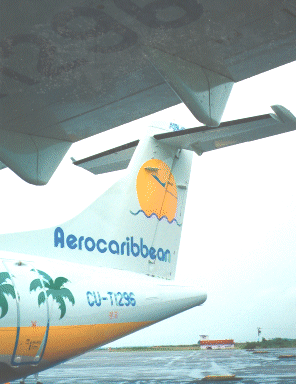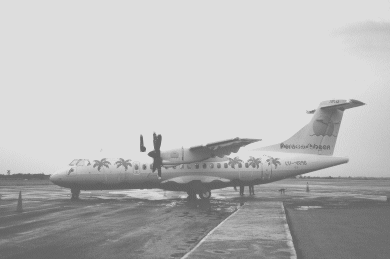
Andrzej Jeziorski/HAVANA
The Franco-Italian regional aircraft consortium ATR scored a coup when it became the first manufacturer outside the ex-Communist Bloc to sell aircraft to Cuba since Fidel Castro's revolution in 1959.
The sale is the start of a massive fleet renewal programme covering all of the Caribbean island's airlines, which desperately need to replace their fleets of ageing Soviet-built aircraft. In recent years, tourism has become the biggest earning industry for the island, which suffered a 35% shrinkage in its economy between 1989 and 1994 because of the loss of its biggest trading partner, the Soviet Union.
Now tourism and transport officials are hoping to build on this burgeoning trade, revamping their airport infrastructure and airline fleets, and anticipating the opening up of potentially lucrative air links with Castro's long-time arch-enemy - the caricatured Señores Imperialistas of Government propaganda posters scattered around Havana - the USA.
One early step towards this reconciliation was taken in mid-July when direct air links were re-opened between Miami and Havana, two years after the USA terminated the flights in retaliation to two US civilian light aircraft, flown by the anti-Castro group Brothers to the Rescue, being shot down. Cuban officials claimed the aircraft had repeatedly violated their national airspace. A UN inquiry ruled they were shot down over international waters, and that Cuba's action was illegal.
Transport officials in Havana now predict relations between the two countries will warm rapidly, allowing the island to take advantage of a potentially lucrative market formed by the substantial Cuban-American community and other tourists.
The Cuban airlines' plans for fleet renewal will remain blocked, however, as long as the current US trade embargo is maintained. Tour operators are reluctant to place foreign travellers on Soviet aircraft, so the national airline Cubana is leasing three McDonnell Douglas DC-10-30s from France's AOM for long-haul flights until it can procure its own new fleet. In the meantime, Havana's airport has begun to resemble an elephant's graveyard of Ilyushins and Tupolevs in Cubana colours.
As a US company, Boeing is excluded from making sales efforts in Cuba as long as the embargo is in place. Airbus Industrie, on the other hand, has opened up contacts with Cuban authorities despite being prevented from selling any of its aircraft in Cuba for now because they include more than 10% US content.
Thus, the fleet renewal has begun modestly with the acquisition of turboprops for regional carriers Aerocaribbean and Aerogaviota. A contract was signed on 24 June by ATR with Cuba's state-run holding Corporacion de la Aviacion Cubana (CACSA) for an initial total of four secondhand ATR 42-300s - two aircraft for each of the carriers.

FIRST DELIVERY
The first delivery was to Aerocaribbean on 30 June, while Aerogaviota will receive its first new turboprop in November. Aerocaribbean's first ATR is a 10-year-old aircraft traded back to ATR by American Eagle as part of its upgrade to new generation ATR 72-500s. It has been fully reconditioned and delivered on a lease-purchase basis, initially to CACSA's own import-export company Aviaimport, with ownership to be handed over once the full price has been paid.
Subsequent aircraft are being delivered on similar terms. ATR senior vice-president commercial Alain Brodin places the overall value of the sale at about $24 million. According to Brodin, the company expects to sell at least six more aircraft to Cuba in the next two years. He adds that this is a conservative estimate, bearing in mind the large fleets of turboprops which need to be replaced. "I think there is significant potential [in Cuba]," says Brodin.
He says contacts with the island were initiated in 1993, but went dormant as a result of Cuba's economic woes, reviving in November 1997. Canada's Bombardier was "very active" in promoting its products, hoping to take advantage of traditionally mellow relations between the two countries, but ATR finally came out ahead and won the order.
As part of the deal, the manufacturer has trained four crews and a group of mechanics to date, with more to come. The European consortium has also stationed a fleet service representative in Havana to liaise with the customers. Larger overhaul tasks will be carried out by Aerospatiale in France.
Aerocaribbean owns a fleet of one Antonov An-24, one An-26, three Ilyushin Il-18s and a Yakovlev Yak-40 regional jet, operating scheduled services to Varadero, Cayo Largo, Santiago and Santa Cristo, with international freight and passenger charters. Aerogaviota is primarily a charter carrier and operates 13 An-26s, eight An-26Bs and four Yak-40s.
Cubana's own turboprop fleet includes 10 An-24s and 20 An-26s, alongside about eight Fokker F27-600s due for retirement in the next few months. The carrier also owns a jet fleet of about 12 Ilyushin Il-62Ms, two Il-76MDs and four Tupolev Tu-154Ms, as well as six Yak-40s and three Yak-42Ds.
The fleet replacement need is therefore substantial, with tourism expected to grow from 1.2 million last year to 2 million by 2000, bringing much-needed hard currency to the island. Meeting this need, however, depends on the US lifting its trade embargo, which, in turn could lead to even faster growth in tourism.
Some observers expect that there will be an opening of the US market sooner rather than later. They say that once the country is open for US visitors, growth will explode, although they warn that growth could flatten out. One observer, however, says that "-if the [Cuban authorities] are careful about how they restore Havana, interest could be maintained".
Some officials privately add that US President Bill Clinton is in any case serving his final term, and is therefore less concerned about the opinion of the substantial anti-Castro Cuban-American lobby. This, they believe, could accelerate the lifting of the 37-year-old embargo which has cost Cuba an estimated $60 billion of lost business.
The signs are positive. Clinton recently placed a six-month waiver on the Helms-Burton Act - which allows Americans to sue foreign businesses which operate on property seized from the USA by Castro. The USA has also opened up an air corridor through its airspace for flights between Cuba and Canada, and, on 15 July, direct flights resumed between Havana and Miami after a 29-month suspension, when a chartered United Airlines Boeing 767 arrived at Havana's Jose Marti Airport with over 200 passengers, largely Cubans living in the USA, to be greeted by cheering crowds. The flight was organised by Miami-based ABC Charters, one of nine companies granted permission to fly to Cuba by the US treasury department. The remaining eight comprise seven small charter companies, and American Airlines.
The US Department of State announced in mid-June that it had authorised Cubana to use two routes over US territory to fly to Canada, and that normal air traffic control services would be provided. Cuba had been petitioning the International Civil Aviation Organisation (ICAO) for years to demand that the US fulfil its obligations under international civil aviation agreements and allow the flights, but until June, Washington had declined.
COSTLY DIVERSION
Cubana was therefore forced to fly 370km (200nm) east of the US coastline to Toronto and Montreal, increasing its costs. The state-run Cuban press has played down the significance of the US move, with the newspaper Granma pointing out that the US "has done no more than to act in accordance with its obligations to the ICAO, albeit after an extremely long delay". The newspaper also points out that Cuba has kept open three air corridors, frequently used by US carriers, and accuses the USA of using one of these corridors to "spray an insect blight" over the island in 1996 to ruin crops.
However grumpy the press reports, CACSA officials are more positive about these signs of improved future relations with the USA. The holding company has been running a massive airport improvement programme in anticipation of the tourist boom, with the construction of new airports at Holguin and Camaguey, the modernisation and expansion of Cuba's second largest airport at the holiday resort of Varadero, and the construction of a $55 million third terminal at Havana, built with a combination of private investment and Canadian aid.
According to CACSA's director of investment and development, Daniel Casal, the new Havana terminal has been designed to handle 3 million passengers a year. Planned further extensions could boost that capacity to 10 million. This would have to include the addition of a second runway, parallel to the current, 4km-long runway 06-23. A new control tower should be operational in a year's time.
The holding company is also planning an upgrade of the ATC system to increase automation and improve communications between Cuba's Russian-equipped radar stations.
In January 1997, the ICAO set up the Trainair scheme in Cuba, with financial and logistical backing from Spain's International Co-operation Agency and the Spanish Airports and Air Navigation corporation. The scheme has set itself the goal of retraining Cuban civil aviation executives and managers from CACSA-owned companies in administration and management techniques.
Earlier this year, El Salvador-based Grupo TACA launched Cuba's first private-sector airline, Inter. Managing director Ben Baldanza has called the airline "-the first completely capitalist venture in Cuba since 1959". Whisper it quietly in Havana's Plaza de la Revolucion, but the times they are a-changing.

Source: Flight International



















